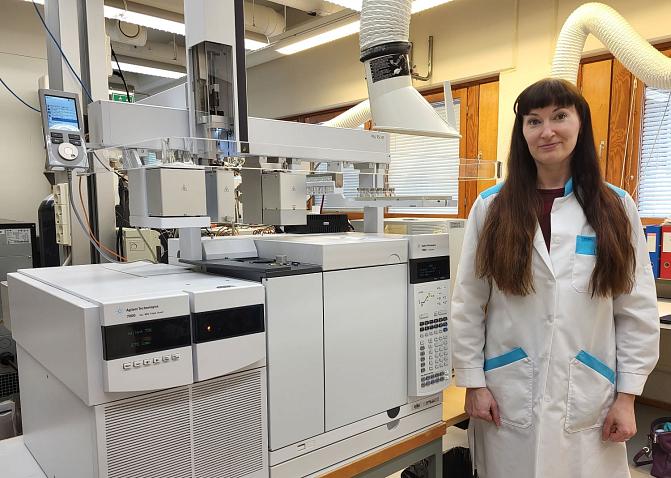
Tools from sensory perceptions – Luke’s solutions to mitigate off-flavors in fish products
On this page
Fish farmed in recirculating aquaculture system can develop unwanted off-flavors. Traditionally, unpleasant flavors are removed by depurating the fish in clean water before sale. However, depuration is an expensive and time-consuming process, which is why efforts are made to minimise its use. The Natural Resources Institute Finland (Luke) has developed various solutions to support and accelerate the removal of off-flavors.
In recirculating aquaculture systems, off-flavors accumulate in fish as metabolic by-products of microbial activity. At low concentrations they are not toxic to humans or fish, but they often give fish a muddy or other unpleasant taste and smell. Many off-flavor compounds have lipophilic properties and readily accumulate in the fatty flesh of fish. The removal of off-flavors is slower than their accumulation, and fish often must be kept in clean water without feeding for two weeks. This process, known as depuration, is not cost-effective because it requires a lot of water, the tanks are not used for production and the fish lose weight.
The solution is based on a scientific understanding of the phenomenon
Research in off-flavors has traditionally focused on two compounds, geosmin and 2-methyl isoborneol. Luke was among the first to discover that off-flavors are produced by dozens of different compounds, including terpenes, aldehydes, fatty acids, and ketones.
In the past, the evaluation of off-flavors was typically based on sensory perception, which led to varying evaluations due to different perceptions between people. A method was developed at Luke to chemically analyse off-flavor compounds and determine their concentrations. Over the years, as experience and observations have been gained, the method has been extended to more and more compounds.
"The method of off-flavor analysis has been widely adopted in Finland and internationally. It is used especially in research, but also in process management and product development in companies," says Petra Lindholm-Lehto, senior researcher at Luke.


Good water quality is a prerequisite
The success of recirculating aquaculture depends on good water quality and suitable conditions for the farmed species. Good water quality is also the starting point for avoiding off-flavors. The method of off-flavor analysis enables the systematic development of the recirculating aquaculture process. Simply optimising conditions is not enough, which is why researchers have tested the dosing of different oxidising compounds at different stages of the process (links: Lindholm-Lehto et al. 2019; Pettersson et al. 2022). The tested chemicals degrade in the system to oxygen and water and do not accumulate in the fish.
"We have studied the effects of peracetic acid, hydrogen peroxide, ozone and combinations of these on the formation and removal of off-flavors. Many of the compounds we have studied are able to temporarily reduce off-flavor concentrations in the water, but do not provide a longer-term effect. Very high doses, on the other hand, can be detrimental to beneficial microbiota or impair fish welfare. The best results have been obtained with continuous dosing, where several compounds are dosed at the same time," explains Lindholm-Lehto.
The results of the research have been rapidly put into practice and are also being exploited on an industrial scale.
The results of the research have been rapidly put into practice and are also being exploited on an industrial scale. By dosing oxidants during the depuration phase, the depuration process can be accelerated to a certain extent, thus reducing production costs.
Innovations can help
New innovations have also been introduced to reduce the harm caused by off-flavors. Most recently, a collaborative project between VTT and Luke enabled the capture of off-flavor compounds directly from circulating water, thus reducing their concentrations in water and in fish. The method is based on the use of renewable material. The results were of such interest that invention disclosures were filed in 2023 in both organisations. A patent application for the method is planned in the near future.
The formation of off-flavors in recirculating aquaculture is likely to continue. However, the causes of their formation, the most problematic production steps and the link to water quality are better understood. In addition, advances in analytical techniques have made it relatively easy to determine the compounds and their concentrations, which will provide a basis for any further development work.
In the future, the depuration stage is unlikely avoided altogether, but it may be shorter and cheaper. Most importantly, consumers will not be disappointed at the fish counter, but will be able to rely on the good quality of the fish.
More information
- Effect of peracetic acid on levels of geosmin, 2-methylisoborneol, and their potential producers in a recirculating aquaculture system for rearing rainbow trout
- Developing a robust and sensitive analytical method to detect off‑flavor compounds in fish
- Effect of ozone and hydrogen peroxide on off-flavor compounds and water quality in a recirculating aquaculture system
- Quality of rainbow trout (Oncorhynchus mykiss) reared in recirculating aquaculture system and during depuration based on chemical and sensory analysis

